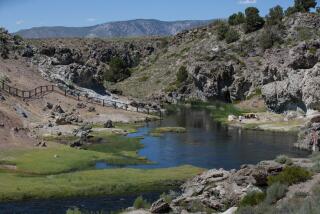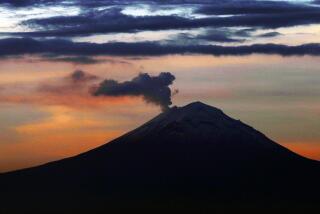Risks of Mt. Rainier Eruption Pondered : Nature: Although the majestic volcano has not had a major blowout for 2,000 years, experts say it has the potential for more destruction than caused by Mt. St. Helens.
- Share via
SEATTLE — Mt. Rainier, the majestic 14,410-foot snow-white volcano worthy of many a postcard, hasn’t erupted in 150 years and it’s not known when it will erupt again.
But when it does, scientists say, it’s likely to wreak devastation on a scale dwarfing the cataclysmic May, 1980, eruption of a Cascade Range neighbor, Mt. St. Helens.
Even without an eruption, a robust landslide or avalanche at Rainier--triggered by an earthquake, say--could send enough water, mud and debris cascading downslope to bury some towns.
About 60 volcano experts discussed these threats and other puzzles posed by Rainier at a conference at the University of Washington. Researchers will use the conclusions to come up with a 10-year plan to study the mountain.
Rainier is one of nine volcanoes worldwide--and the only one in the continental United States--that the International Assn. of Volcanology and Chemistry of the Earth’s Interior has deemed worthy of such extended study.
“The hazards at Rainier don’t seem to be very often, and there are those that exist that are really small, like minor debris avalanches,” said Steve Malone, a University of Washington seismologist who led the session one September weekend. “But it has the potential for really big ones, so much more destructive or covering so much more area than what we saw at St. Helens, that you really have to show it some respect.”
The eruption at St. Helens leveled 230 square miles, killed 57 people and sent up an ash cloud that circled the globe.
“If the May 18, 1980, eruption occurred at Mt. Rainier, I would say the consequences would be even more deadly,” said Chris Jonientz-Trisler, a natural hazards program specialist with the Federal Emergency Management Agency in Seattle.
“You would have ash being spewed from a volcano that is much closer to Sea-Tac (Airport). That causes tremendous problems for airplanes,” he said.
“You also have a lot more glacial material up at Rainier, hot magma that can melt large amounts of ice, break up the glaciers and send it spewing downriver quickly.”
Rainier has 156 billion cubic feet of snow and ice, equivalent to nearly 200 years’ worth of Seattle water use. And with Tacoma only 40 miles away and Seattle fewer than 60, many more people live near Rainier than there were near St. Helens.
Rainier’s eruption 150 years ago resulted in only a minor dusting of ash. Its last major eruption happened 2,200 years ago.
Scientists say there’s no way to pinpoint when Rainier will erupt again. But the fact that it will means people should plan now to lessen the disastrous effects, said Don Swanson, a U.S. Geological Survey scientist and a University of Washington affiliate professor of geological sciences.
“Area governments must get involved to pool resources for a regional council. That’s the only rational way to deal with natural hazards,” he said.
Pierce County, for example, will take the danger of eruptions and mud flows into account as it writes its comprehensive growth-management plan, said Al Eggers, a University of Puget Sound geology professor and a member of the citizens advisory group working on the plan.
A USGS report by Kevin Scott, Pat Pringle and James Vallance of the USGS’ Vancouver observatory said a mud flow could hit the town of Orting, where the Carbon and Puyallup rivers converge, in one to two hours.
The Orting School District has challenged a county law that prohibits school construction in the path of a mud flow.
Jonientz-Trisler noted that towns such as Buckley, Sumner, Kent and Auburn sit on a valley that was created by a massive Rainier mud flow that stretched westward to Puget Sound 5,000 years ago.
Even a much smaller mud flow like one that occurred in 1989 was strong enough to register on seismographs in Washington and Oregon, she said.
“Had people been in the area at the time, that would have been disastrous to them,” Jonientz-Trisler said. “Could a larger one take place? The answer is yes.”






